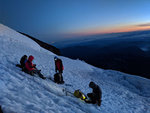
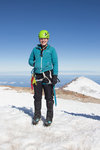
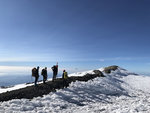
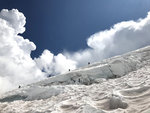
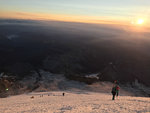
We woke up on the Inter Glacier on August 3, two days before our summit attempt on Mt. Rainier, to clouds that had rolled in from all directions until there was little to see but blank, white nothing a hundred yards in any direction.
I couldn’t see from the tent, but there were valleys below, stretching thousands of feet down to the Glacier Basin Campground at the end of the established trail. Past the camp was the climbers’ trail, then no trail at all, and my team was there to climb.
There’s little to say about Rainier that hasn’t been said — about 5,500 people reach the summit every year, and over the past several decades, nearly half a million people have attempted it. Anyone driving Western Washington highways has likely had the clear-day experience of coming around a bend in the road and drawing in a long breath at the sight of it.
Even so, I had to see it up close for myself. I took a basic alpine climbing class this spring and knew that Rainier would be the first thing anyone asked about once I said I was interested in mountaineering. Really it was the other peaks, the smaller ones with lesser-known names, that I imagined myself chasing, but Rainier loomed on the horizon in the clear early summer like a beacon.
Its magnetism swirled together in my head with other climbers’ talk — was it as challenging as they said? — and a pure curiosity — what was it like up there?
So, without hesitation, I went. I teamed up with seven other climbers from the Washington Alpine Club to follow the lesser-traveled Emmons-Winthrop route to the top. Beginning our ascent was like standing on the shores of an unfathomable ocean, the snow making a mirage of distance and vertical gain. When we were still on the dirt trail, two miles into the first day’s hike, we came around a corner to see the mountain naked before us and laughed at how close it seemed. Only that night, when we reached our first camp at the Inter Glacier, did I start to get a human sense of scale. A Catholic boys’ group passed by in the evening, headed up, and it took over an hour before I lost sight of them. Their voices echoed off the snow even as the sun set, and every so often, one of the teenagers would call out to the priest: “Father?”
Our group’s leader, Peter Horsman, kept one eye on his dinner and the other on the progress of the ascending team. Peter is a Dutch transplant to the Pacific Northwest who first saw Rainier when he flew stateside for a job interview years ago. As a boy, he’d spent time in the Swiss Alps, looking in awe at the men coming down from the peaks, so when he first glimpsed Rainier, he turned to the stranger in the seat next to him, and, emphatic and gesticulating, said, “Do you see that mountain?” As soon as he’d landed, he called his brother and told him that he was going to nail the interview, and the two of them would climb Rainier the next year. Since then, he’s summited it thirteen times.
Peter is personable, direct, and uncompromising on safety — our climb started weeks before we reached the trailhead, at a bar in Seattle where he sat all seven of us down and asked why we wanted to summit. Gina recently moved from Colorado and wanted to know what it was like to tackle the only 14,000-foot mountain in this state — in Colorado, that kind of altitude was easy recreation.
Two others, Angela and Brandi, had completed the other four iconic volcanoes in Washington: Mt. Baker, Mount St. Helens, Mt. Adams, and Glacier Peak. This would be their fifth and last in the series.
Peter asked this question because he needed to know that we wanted it. It didn’t matter the reason, only that there was one. At some point during the summit push, anyone who didn’t really want to get there would give up, he explained. Privately, I wondered whether my curiosity was enough, and hoped Rainier itself would supply me with more motivation.
I shouldn’t have worried. When I’m out in the mountains, there’s always something of the same experience, and I want it every time: boots in the snow, I have to pay attention to my footing, and daydreams and anxieties can only take me so far away. I’ve heard elsewhere that attention is a form of love, and what is most distinct about climbing the volcanoes is the silence: distractions gone, I hear my own breathing and feel my body moving.
As soon as the clouds cleared from the Inter Glacier, it was time to climb. We moved up to Camp Schurman, the last stop before our summit attempt, and set up our tents. By 7:30 p.m., wind whipping at the tent fabric, I was curled in my sleeping bag with sweet anticipation in my veins. We’d gazed up at the towering summit in the late afternoon, and it was like walking up to the edge of a bridge knowing that the jump is coming.
The wake-up call came at 11:30 p.m., and I shot awake as soon as I heard Peter rustling. Within a few minutes, I’d harnessed up, tied myself into the rope, and began shifting my weight from foot to foot to keep my toes warm. We got moving just before 1:00 a.m., a typically early start that would keep us from having to climb through a mess of melted, slushy evening snow. In the dark, the world extended no further than the circle of light from my headlamp. Brandi tailed the first four-person rope team and I headed the second. Up front, Peter set the pace, slow enough that I took a breath between each step. Was this meditation? I had no choice but to notice the expansion of my lungs, to slip into a slow-motion rhythm. I glanced up to gauge the distance between myself and Brandi, trying not to rear-end her with my helmet. Even when she was just a few horizontal feet in front of me, I had to crane my neck to see the top of her head. Each step gained as much height as it did distance: hours and hours of climbing a Stairmaster in the dark. Seattle glittered far below.
The pre-dawn breaks all blurred together. We took one every hour — I wasn’t sweating, not panting, but this was an exhaustion of endurance, not cardio. Breaks lasted ten minutes and required us to eat, drink, and relieve ourselves quickly enough that we didn’t get cold. My body reminded me of nothing more than a paper shredder that I had to endlessly feed to keep running—we burned calories so quickly that the moment we stopped, I inhaled whatever snack was closest.
The higher we got, the colder the air, the readier I was for first light. The water in my bottles froze between breaks. I punched through the top layer with my ice axe, but it was so cold that I barely drank anything. When we took a break above 12,000 feet, everyone added a warm jacket for the five minutes we spent sitting down. I chewed rock-hard gummy candy as the sky turned blue-grey and silhouettes of other, smaller mountains sharpened into distinction down below.
There was an edge to everything up there—the cold, the narrowing of my attention whenever anyone shouted “Crossing!” to indicate that they were stepping over a crevasse. Collectively, we would tense up for the few seconds until the next yell: “Clear!” In the smudgy darkness, I could occasionally see Peter test snow bridges with his ice axe, plunging it straight through into the black gulf of a hidden crevasse. I kept a constant, low-grade awareness of how taut the rope was behind me.
This part of mountaineering seems unglamorous, and it is. Mountaineering is a sport, but not one you could pay me to watch. Being present and focusing your attention means that ultimately, a successful climb is built of nothing more than putting one foot in front of the other at absurd hours of night. And yet, there we were, wanting to be nowhere else. Finally, the sun broke to the east.
What a difference it made to see. Before, I’d checked scale and distance only by the glow of headlamps far above and below us—a line of climbers following each other up the route. Now, the snow bridges and crevasses showed themselves, and that magnetism I’d felt from Rainier even within Seattle city limits expanded and pulled me closer. The sunrise washed the snow in a pale orange light, and when we turned around we could see wildfire smoke pooling in the valleys.
For our last break on the snow, I was dizzyingly happy, finally hungry, blessedly warm—with less than 1,400 feet left to climb, the summit felt so close. Peter knew better. Up that high, the clock was ticking on altitude sickness, and it didn’t take long after we started moving for a heaviness to trickle into my muscles. I suddenly remembered how little I’d been drinking.
The last push to the summit was a mess of kitty litter, loose gravel that slid beneath every step. By the time we started up it, our team was panting in the thin air. We were on hour eight of climbing, and I’d have been surprised at how slow I was going if I weren’t surprised to still be capable of moving at all. My body inched forward like a deadweight, and everywhere in my peripheral vision, the Cascades filled the horizon with an almost abstract beauty, like a hazy desktop background.
On top of the crater, the summit was massive, relatively flat for hundreds of yards. Peter overshot what’s technically the highest point, so we walked over it without realizing, then sighed, turned around, and backtracked to victory. Mt. Adams nosed up through the smoke like the tip of an island. I sat down, the world around me pulsing, and tried to guzzle all the water I hadn’t drunk during the ascent. My teammates drank a Rainier beer, took photos, and shared ibuprofen. We were halfway there, with five hours left to descend.
In a video we’d laugh about later, Gina recorded herself at the top, swinging the camera around to show the beauty of it. I wanted more than anything to lie down and go to sleep there next to the summit register, but when altitude sickness sets in, there’s nothing that can assuage it like descending into sweet oxygenated air. When we went to rope up again, Peter asked me if I felt confident leading the team down, and I hesitated before admitting that I felt sick. He nodded, and just like that, we mixed up the rope teams.
Woozy, my head pounding, I forced myself to move. The next several hours were some of the hardest I’ve ever spent outdoors, but there was never any question of whether we’d make it, even when I shouted ahead that I might have to pause our rope team to throw up. The sun reflected off the soft snow and burned my chin, and I slipped through the mush on steep descents. Why did I ever think this was a good idea? Glacier bees zipped around our heads, but finally, as we made our way toward the final crevasse field before camp, my mind began to clear.
Back there, under 10,000 feet, we were practically swimming in oxygen, and the thunderous black clouds that rolled towards us precluded any chance of leaving the glacier that night. Stepping back into the safety of camp, I exhaled in relief. We piled all our lifesaving metal gear—crampons, ice axes, harnesses with steel buckles—in a depression in the snow to act as a lightning rod, then crawled into sleeping bags just as the patter of rain turned to sleet. I held a hot water bottle close to my chest and let its radiating comfort lull me to sleep.
I woke up for good at six the next morning after sleeping for thirteen hours. With a cup of coffee in hand and normal levels of oxygen in my blood, it had all been worth it. We took our hot drinks, perched outside the ranger station, and looked up at the summit—indifferent to us, unchanged by our presence. “We were there,” we marveled, surprised to find it true.